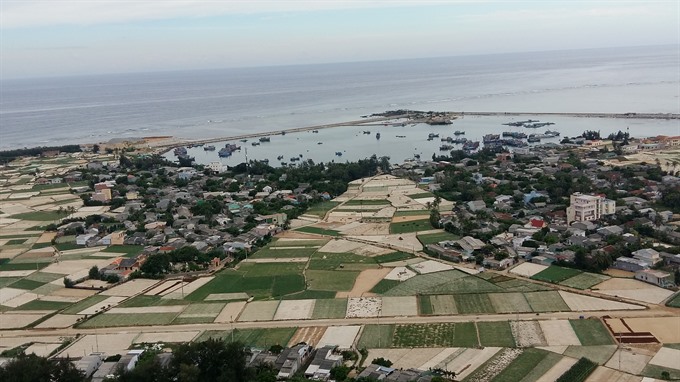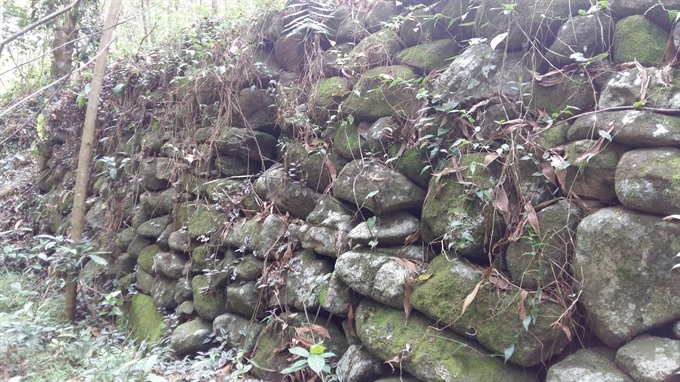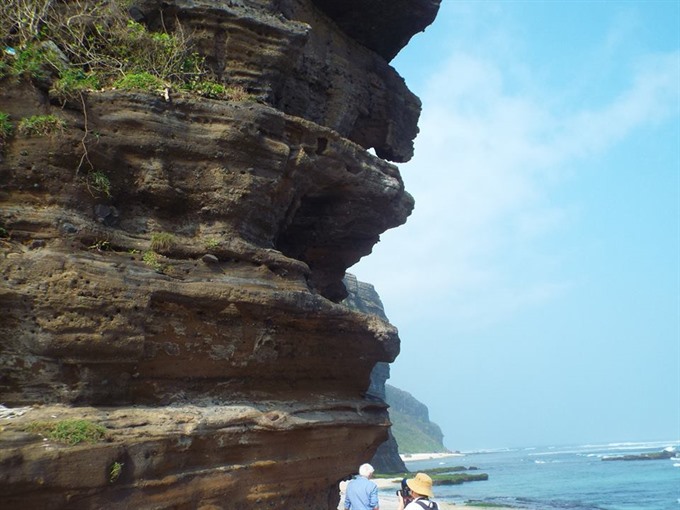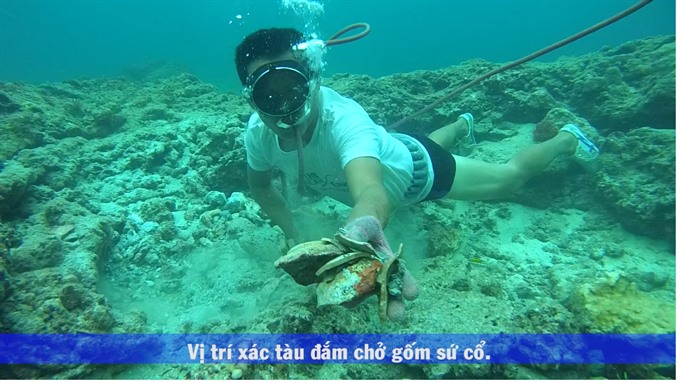 Sunday/Weekend
Sunday/Weekend

Having implemented series of geological surveys and researches on Lý Sơn Island and a large coastal and mountainous area in Quảng Ngãi Province, experts from the Việt Nam Institute of Geosciences and Mineral Resources and international scientists proposes to build up a 2,000sq.km site for a Global Geo-Park for approval by UNESCO.
 |
| View from above: An overview of Lý Sơn Island in Quảng Ngãi Province. — VNS Photo Công Thành |
by Bùi Hoài Nam
LÝ SƠN ISLANDS — A giant, outdoor, natural museum. That’s what experts believe 2,000sq.km of land in Quảng Ngãi Province could soon become.
Proposals have been submitted to create a Global Geo-Park around Lý Sơn Island and large coastal and mountainous areas nearby.
Experts from the Việt Nam Institute of Geosciences and Mineral Resources along with international scientists hope the park plans will be approved by the UN cultural agency UNESCO.
The Director of the Việt Nam Institute of Geosciences and Mineral Resources, Trần Tân Văn, said the Quảng Ngãi Geo-Park would cover a large area above and under the sea and land from Lý Sơn Island to the districts of Bình Sơn, Tư Nghĩa, Nghĩa Hành, Mộ Đức, Ba Tơ, Sơn Hà, Tây Trà, and Sa Huỳnh.
He said the Geo-Park will include important values of history, culture and nature.
“Naturally, the province has an abundance of geological and culture heritages that are believed to have formed from the evolution of Paleo-proterozic Era.
“Current lagoon systems, rocks, sediment left from the era would promote the province as a giant outdoor museum,” Văn said.
He said the area already boasts a number of historic landmarks, including ancient ports of Champa, Đại Việt (Great Việt) and Sa Huỳnh, and Sơn Mỹ vestige museum, Sa Huỳnh museum, and Trường Lũy (Great Stone Wall) in Nghĩa Hành District.
The geo-park will include 7,925ha of the Lý Sơn Marine Protected Area, 1,000ha Cà Đam Nature Reserve and another 39,000ha reserve in the west of Ba Tơ District, he added.
In 2012, Vietnamese archaeologists salvaged a 700-year-old cargo vessel from the sea off Bình Châu Commune of Bình Sơn District, and the area will also be included in the Geo-Park boundary.
 |
| Heritage: An ancient stone wall in Nghĩa Hành district. It was recognised as the National heritage site. — VNS Photo Công Thành |
Geological value
Setsuya Nakada, who is chair of the Advisory Committee of the Global Geo-Park Network, said the central province is really an abundant site of heritage values with a mixture of culture and geology diversity, and it would be possibly promoted as a geo-park site in the global geo-park network.
“I have visited Lý Sơn Island twice, and witnessed that the area of geo-park has been enlarged with rich values of culture and geology. At least five volcanoes and potentially active volcanoes occurred at central and south of Việt Nam in the Neogene-Quatenary (about 30 million years ago),” Nakada said.
He added those volcanic activities in Việt Nam are related to the subduction zone (Ring of Fire in Pacific region), and the formation of the South China Sea (called East Sea in Việt Nam).
Nakada said the volcanism in Lý Sơn Island is similar to those in the sea of Japan (in west of Japan), and Jeju Islands in South Korea.
Nakada, who is director general of centre for integrated volcano research, and national research institute for earth science and disaster resilience in Japan, warned that rubbish disposal has polluted the environment on Lý Sơn and the provincial government needs a strong management structure and action plan to protect and preserve the island.
“The boundary of the geo-park should be expanded to enrich the heritage value. The nature environment should be clean and rubbish littering must be stopped. However, it needs to reconsider the island’s capacity in hosting masses of tourists,” he said.
He said the story on the sunken ships off the coast of Bình Sơn District and other traditional stories should be told to add to the diversity of region.
“Successive research to understand the international significance of geology is requested. Then local people should understand the significances by their own words,” he said.
He said in preparation for UNESCO-recognition global geo-park submission in 18 months time, the local government should promote the management, protection, education and tourism on proposed sites.
 |
| Rock stars: A rock cliff in Lý Sơn Island. Basalt layers and rocks found in the Island were believed to be from volcanoes 30 million years ago. — Photo courtesy of Chu Mạnh Trinh |
Ngô Xuân Thành, a researcher of volcano at the Hà Nội-based Mining and Geology College, said magma sample researches and field examination showed the volcano erupted to creat Quảng Ngãi somewhere betweeen 6.9 million and 9 million years ago.
“Samples of basalt and ancient rocks found in Ba Làng An and Lý Sơn Island were from the Miocene period. And eruptions in Lý Sơn and An Bình islet were different. Ash and basalt found in the Câu cave in Lý Sơn was a possible vestige of sea in the Flandrian when the sea level was six metres higher than now,” Thành said.
Expert Phạm Đức Lương said the Island of Lý Sơn witnessed at least three periods of volcanism with eruption areas from Lý Sơn to Phú Yên Province and Phú Quý Island in Bình Thuận Province.
Trịnh Long, an expert in geology, said samples of metamorphic and igneous rocks found at Quảng Ngãi believed the geological formation was from 250 million to 460 million years ago.
He said at least three complexes of metamorphic and igneous rock and 12 magma complexes helped create some areas in Quảng Ngãi (Ba Tơ and Trà Bồng districts).
He said some sections of damaged walls of stone, which was found in Nghĩa Hành District, were part of the 130km stone wall from Quảng Ngãi to Bình Định.
Đoàn Ngọc Khôi, from Sa Huỳnh Museum, said the Sa Huỳnh Culture (2,500 to 3,000 years ago) was almost undamaged in the province (tombs and other relics of Sa Huỳnh community).
Challenges
The booming of tourism and construction in Lý Sơn Island has seen as serious threats to the geo-park submission.
In early 2018, the province agreed a research and survey plan of developing luxury resorts and entertainment project by a property developer, FLC Group, on 1,243ha of Lý Sơn Island, An Bình Islet and the coast of Bình Châu Commune in Bình Sơn District.
As planned, the FLC Group project would need a land clearance plan on 184ha rice fields, 55ha protective forests, 86ha rural residential land, 502ha of farming land, and removal of a border guard station on 1ha.
It’s expected that more than 1,100 households will be relocated when resort construction begins.
The province agreed an advanced fund of VNĐ550 billion (US$24.3 million) to compensate for land clearance, and open a passageway to the public beach every eight kilometres on the coast of Bình Châu Commune.
Nguyễn Xuân Nam of the Việt Nam Institute of Geosciences and Mineral Resources said the proposal of developing resort project in Lý Sơn Island and on the coast of Bình Châu Commune would overlap to the global geo-park submission on the Islands.
 |
| Sunken treasures: A diver searches ceramic fragments underwater off the An Bình Islet of Lý Sơn Island. — Photo courtesy of Đoàn Ánh Dương Company |
Director Văn of the Việt Nam Institute of Geosciences and Mineral Resources warned that the proposed area of FLC resort project will be in a disaster risk area as storms and tsunamis would clear any buildings there.
He said any tourism and property projects on Lý Sơn Islands and the coast of Quảng Ngãi must respect the interest of the community and not just be about business profit.
“We encourage projects that help local community improve their lives, while balance environmental and heritage values. We do not support projects that businesses only get benefit from heritage and leave community away,” Văn said.
He said tourists came to explore the unique heritage of the islands and the volcanic structures left from eruptions millions of years ago, but not to shop or stay at luxury hotels.
Researcher Chu Mạnh Trinh said ancient volcanic structures would be damaged if mass developments of hotels, resorts and concrete buildings were allowed.
Trinh suggested the province could design the islands as a site for day-time visits only, while entertainment, accommodation services, cuisine and shopping centres could remain on the mainland.
According to archaeologists, Lý Sơn Island is a dormant volcano. The terrain of the island was created from eruptions 25 to 30 million years ago, leaving landscapes with rocks, caves, cliffs, rock arches and a lake.
The main island has abundant relics related to the Sa Huỳnh, Champa and Đại Việt cultures that existed on the island for thousands of years.
Ceramic fragments and other antiquities from archaeological excavations revealed the first community living on the island some 2,500-3,000 years ago.
The island, known as the ‘Kingdom of Garlic’ in Việt Nam, is a tranquil destination with 21,000 inhabitants, most of whom make their living from farming garlic and spring onions and fishing.
Provincial Party secretary Lê Viết Chữ said the province would reconsider the project on how to balance benefit of community and businesses as well as environment and heritage protection.
The Island is also planned to build as a site of the Asian Turtle Conservation programme, according to the International Union for Conservation of Nature (IUCN). — VNS




